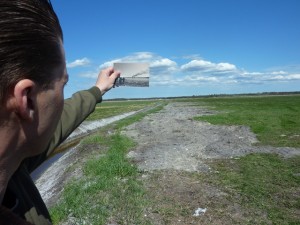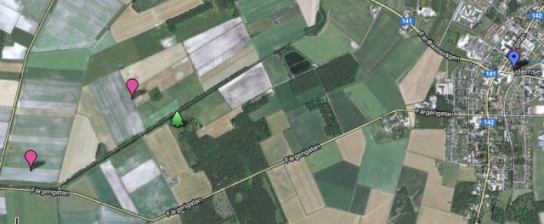10 May Mästermyr A or Mästermyr B
My son Johnny and I left England on Sunday, May 6, 2012. We have been to London and to Thurleigh, the airfield just north where my Dad and his crew’s bomber group, the 306th, were stationed during World War II. When we began our adventure I had visions of being able to write daily but there has been no time. I’ll catch up gradually on our experiences … it’s been literally one bombshell after another.
Getting to Gotland was no small feat. We left Heathrow for the Arlanda airport in Stockholm then had to run with our suitcases for Terminal 3 to catch the last plane to the island. Made it! We flew over on a Skyways propeller plane and watched below much of what the Liberty Lady crew would have seen on their last flight March 6, 1944 … more than sixty-eight years ago. Water, water, water, tiny islets then finally … Gotland!
When we landed at the Visby airport our new friend Ulf Gahm was there to meet us. Thank goodness! Ulf is editor of Gotlandsguiden, the island’s primary tourist publication, and we “met” online last year when he wrote a story about the Liberty Lady. Our hotel was in the medieval city of Visby, and that is a whole other post someday.

Mattias Enqvist compares the site with the actual photograph taken in 1944. His grandfather, as a member of the Home Guard, helped guard the plane.
The next morning Ulf picked us up and drove us for an hour south to Hemse, where we were to meet up with several gentlemen who either jumped on their bikes and pedaled to the Liberty Lady landing site, who had relatives who were there or who just had a special interest. As we were to learn, the B-17’s Landing made a big impact on this little village. Three of our four direct witnesses spoke almost no English so Ulf’s wife Eva came along to assist with translations.
What we know is that as the Liberty Lady crew flew low over the island they began to look for possible landing spots and saw the Mästermyr … a large boggy field. There were low stone fences so the pilots had to land wheels up.
Now, more than sixty-seven years later, as the eyewitnesses gathered at the site, each related their memories of the day.
We settled that the plane came down on one or two landing spots, as shown in the Google map below. The site to the right seems to be the most likely. A farmer who lived just east was one of the two men first to arrive. The crew had just blown up the cockpit of the plane with an incendiary and ran over a channel of frozen water into a copse of trees. The farmer pointed them out to the Home Guard when they arrived soon after. At this point, the crew still had no idea where they were and assumed that they might be in a Nazi-occupied territory. It didn’t help that the first Home Guardsman that approached them carried a German rifle!
The guards called for the local schoolteacher to bicycle over. Only when he was able to speak in English to the boys and reassure them that they were in a neutral country did they begin to believe that they were safe.
So we still are not sure … Mästermyr A or Mästermyr B … but the locals are talking about it and helping us search for clues. Hopefully, we’ll know soon!

Two different possibilities for the exact landing site … both west of Hemse on the island of Gotland, Sweden. The tree marks the spot where the crew hid in the trees.


Bobby Lee Silliman
Posted at 08:34h, 11 MayPat,
This is such a thrill following your personal quest to find all the information you can on that eventful day that happened sixty eight years ago! I am sharing some of what you have been posting here with our readers on the Carlsbad Army Air Field Wall Facebook page. It was at the Carlsbad Army Air Field that your father, Herman F. Allen obtained the skills needed to make that battle wounded B-17 make it to Gotland . The rest is history and you are bringing it back to life!
Godspeed and thank you for what you are doing!
Bobby Lee Silliman
Bill Pounds
Posted at 20:51h, 12 MayDear Pat,
I think that they would land into the wind if possible. Are there any weather records available?
Bill